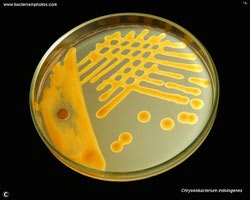Chryseobacterium indologenes
A Microbial Biorealm page on the genus Chryseobacterium indologenes

Classification
Higher order taxa
Bacteria; Bacteroidetes; Flavobacteriia; Flavobacteriales; Flavobacteriaceae
Species
Chryseobacterium indologenes
Synonyms: Flavobacterium indologenes
Description and significance
Formerly Flavobacterium indologenes, Chryserobacterium indologenes is a yellow pigmented, Gram-negative filamentous, non-motile rod and can be found in soil, plants, foodstuffs and water sources including those found in hospitals [1][2][3][4]. This bacteria is also a facultative anaerobic chemo-organotroph. C. indologenes was first isolated from a clinical specimen and described by Yabuuchi et. al. in 1983 [5]. It is most commonly isolated from human specimens, but has rare clinical significance. There have been recent reports of bacteremia related to C. indologenes as it is often seen in indwelling devices, such as a catheter, but little is know of its significance in clinical disease [2][6][7][8]. C. indologenes is resistant to a wide variety of antimicrobial agents [8]. Because of increasing cases of C. indologenes in bacteremia in hospital settings more work is needed to isolate and determine the role that this organism plays in disease.
Genome structure
C. indologenes has a circular chromosome with near 5.5 Mbp length. It is most similar to C. gleum with a 16S rRNA gene sequence similarity of 98-99%. DNA G+C content has been shown to be 37-39% (mol %) in C. indologenes [4]. New recent classification has updated C. indologenes from it previous classification as Flavobacterium [10].
Cell and colony structure

C. indologenes is a Gram-negative filamentous rod bacteria of approximately 0.5 µm in diameter and 1.0 – 3.0 µm in length. The rods have rounded ends and parallel sides, but no electron microscopy studies have been performed, so little information is known on the fine structure. Colonies are circular, convex, entire, smooth and up to 2 mm in diameter with an aromatic odor. C. indologenes colonies are a deep yellow and are thinner in the central portions than in the peripheral portions [1][3][4].
Metabolism
C. indologenes is a nonfastidious, chemo-organotrophic organism that can respire in anaerobic conditions with nitrate or fumarate used as the terminal electron acceptor. Acid is produced from D-fructose, D-glucose, glycerol, maltose, trehalose, glycogen and mannose, but not from lactose, L-arabinose, ethanol, sucrose, or D-xylose. Catalase, oxidase, phosphatase and strong proteolytic activities are observed in C. indologenes as well as oxidation of carbohydrates. Glycerol and trehalose are not oxidized. C. indologenes is also capable of degrading esculin, DNA, starch and Tween-80 and produces indol. It does not, however produce ß-galactosidase or L-phenylalanine deaminase [1][2][3][4].
Ecology
C. indologenes is most commonly found in soil, plants, foodstuff and water sources including those in hospitals. It is not a member of the normal human flora, but is the most commonly isolated flavobacteria in the clinical microbiology laboratory [3][4].
Pathology
C. indologenes has been documented to cause bacteremia in hospitalized patients. Infections have been linked to the use of indwelling devices [2]. Little else is know of C. indologenes' involvement in clinical disease. The organism is found to be resistant to most antimicrobial agents commonly used to treat Gram-negative bacteria, however, susceptible to those used to treat Gram-positive bacteria [9]. C. indologenes is resistant to cephalothin, cefotaxime, ceftriaxone, aztreonam, aminoglycosides, erythromycin, clindamycin, vancomycin and teicoplanin, while susceptible to piperacilin, cefoperazone, ceftazidime, imipenem, quinolones, minocycline and trimethoprim-sulfamethoxazole [4].
References
3. von Graevenitz, A. (1999). Acinetobacter, Alcaligenes, Moraxella, and other non fermentive gram-negative bacteria. In P. R. Murray, E. J. Baron, M. A. Pfaller, F. C. Tenover, R. H. Yolken, & eds., Manual of Clinical Microbiology (pp. 553-554). Washington DC: American Society for Microbiology. ISBN-10: 1555811264
4. Bernardet, J. F., Hugo, C. J., & Bruun, B. (2010). Genus X. Chryserobacterium Vandamme, Bernardet, Segers, Kersters and Holmes 1994. In W. B. Whitman, N. R. Krieg, J. T. Staley, D. R. Brown, B. P. Hedlund, B. J. Paster, N. L. Ward, et al. (Eds.), Bergey's Manual of Systematic Bacteriology; Volume 4 (Vol. 4, pp. 180-192). New York: Bergey's Manual Trust. ISBN-10: 0683006037
Edited by Jeremy Cunniff student of Dr. Lisa Moore of the University of Southern Maine
